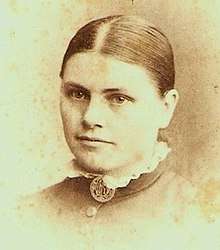Mary Adela Blagg
Mary Adela Blagg FRAS (17 May 1858 – 14 April 1944) was an English astronomer and was elected a fellow of the Royal Astronomical Society in 1916.
Mary Adela Blagg | |
|---|---|
 Mary Adela Blagg as a young woman | |
| Born | 17 May 1858 Cheadle, Staffordshire, England |
| Died | 14 April 1944 |
| Nationality | English |
| Occupation | astronomer |
Biography
She was born in Cheadle, Staffordshire, and lived her entire life there. Mary was the daughter of a solicitor, John Charles Blagg, and France Caroline Foottit. She trained herself in mathematics by reading her brother's textbooks. In 1875 she was sent to a finishing school in Kensington where she studied algebra and German. She later worked as a Sunday school teacher and was the branch secretary of the Girls' Friendly Society.
By middle age she became interested in astronomy after attending a university extension course, taught by Mr. J. A. Hardcastle, John Herschel's grandson.[1] Her tutor suggested working in the area of selenography, particularly on the problem of developing a uniform system of lunar nomenclature. (Several major lunar maps of the period had discrepancies in terms of naming the various features.)
In 1905 she was appointed by the newly formed International Association of Academies to build a collated list of all of the lunar features. She worked with Mr. S. A. Saunder on this very tedious and lengthy task, and the result was published in 1913. Her work produced a long list of discrepancies that the association would need to resolve. She also performed considerable work on the subject of variable stars, in collaboration with Professor H. H. Turner. These were published in a series of ten articles in the Monthly Notices, in which the professor acknowledged that a large majority of the work had been performed by Mary Blagg.
After the publication of several research papers for the Royal Astronomical Society, she was elected as a fellow in 1916,[2] after being nominated by Professor Turner. She was one of five women to be elected simultaneously, the first women to become Fellows of that society.
She worked out a Fourier analysis of Bode's Law, which was detailed in Michael Martin Nieto's book "The Titius-Bode Law of Planetary Distances."
In 1920, she joined the Lunar Commission of the newly formed International Astronomical Union. They tasked her with continuing her work on standardizing the nomenclature. For this task she collaborated with Karl Müller (1866–1942), a retired government official and amateur astronomer.[3] (The crater Müller on the Moon was subsequently named after him.) Together they produced a two volume set in 1935, titled Named Lunar Formations, that became the standard reference on the subject.
During her life she performed volunteer work, including caring for Belgian refugee children during World War I. One of her favorite hobbies was chess. She was described in her obituary as being of "modest and retiring disposition, in fact very much of a recluse", and rarely attended meetings.
Bibliography
- Blagg, M.A., On a Suggested Substitute for Bode's Law, Monthly Notices of the Royal Astronomical Society, Vol. LXXIII 6, April 1913:414:422..
- M. A. Blagg, Collated List of Lunar Formations, Edinburgh, 1913.
- M. A. Blagg and Karl Müller, Named Lunar Formations, London, 1935 — vol. 1, catalogue; vol. 2, maps.
References
- Hockey, Thomas (2009). The Biographical Encyclopedia of Astronomers. Springer Publishing. ISBN 978-0-387-31022-0. Retrieved 22 August 2012.
- "RAS meeting report" (PDF).
- Whitaker, Ewen A. (1999). Mapping and Naming the Moon: A History of Lunar Cartography and Nomenclature. Cambridge University Press. ISBN 0-521-54414-9.